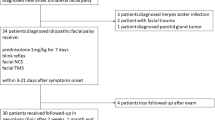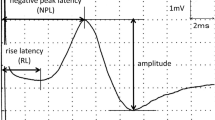Summary
Twenty-four patients with unilateral facial weakness of various aetiologies were investigated using a magnetic stimulator to stimulate the proximal segment of the facial nerve directly (short latency response) and also to activate the facial motoneurons bilaterally via corticonuclear pathways by placing the stimulating coil over the motor cortex (long latency responses). Electromyographic recordings were taken from both mentalis muscles using concentric needle electrodes. Seventeen patients were investigated at various times after onset of idiopathic facial palsy (Bell's palsy). In the acute stage (less than 5 days after onset) short and long latency responses on the paretic side were abnormal, being absent in all but one patient, in whom the short latency response was delayed. These abnormal responses were the earliest neurographic correlate for nerve conduction block. In 4 out of 9 patients seen up to 30 days after onset of palsy, trans-synaptically evoked long latency responses were absent. In patients examined more than 2 months after onset, long latency responses could always be obtained and, in 5 of 8 patients, short latency responses could also be elicited, indicating a return of the direct excitability of the nerve. Five patients with cerebral hemisphere lesions causing mild unilateral facial weakness had absent long latency responses when stimulating over the affected hemisphere, but normal bilateral long latency responses following stimulation over the unaffected cerebral hemisphere; short latency responses were normal. Magnetic stimulation of the brain and of the facial nerve can differentiate between central and peripheral causes of unilateral facial weakness and may prove useful in the early assessment of the degree of conduction block in Bell's palsy.
Similar content being viewed by others
References
Barker AT, Jalinous R, Freeston IL (1986) Non invasive magnetic stimulation of the human motor cortex. Lancet I:1106–1107
Barker AT, Jalinous R, Freeston IL, Jarratt JA (1987) Magnetic stimulation of the human brain and peripheral nervous system: an introduction and the results of an initial clinical evaluation. Neurosurgery 20:100–109
Benecke R, Meyer B-U, Schönle P, Conrad B (1988) Transcranial magnetic stimulation of the human brain: responses in muscles supplied by cranial nerves. Exp Brain Res 71:623–632
Esslen E (1977) The acute facial palsies. Springer, Berlin Heidelberg New York
Hess CW, Mills KR, Murray NMF (1987) Responses in small hand muscles from magnetic stimulation of the human brain. J Physiol (Lond) 338:397–419
Jenny AB, Saper CB (1987) Organisation of the facial nucleus and corticofacial projection in the monkey: a reconsideration of the upper motor neuron facial palsy. Neurology 37:930–939
Kimura J, Giron LT, Young SM (1976) Electrophysiological study of Bell's palsy: electrically elicited blink reflex in assessment of prognosis. Arch Otolaryngol 102:140–143
Kuypers HGJM (1958) Corticobulbar connections in the pons and lower brain-stem in man. Brain 81:364–388
Møller AR, Jannetta PJ (1984) On the origin of synkinesis in hemifacial spasm: results of intracranial recordings. J Neurosurg 61:569–576
Polson MJR, Barker AT, Freeston IL (1982) Stimulation of nerve trunks with time-varying magnetic fields. Med Biol Eng Comput 20:243–244
Rothwell JC, Thompson PD, Day BL, Dick JPR, Kachi T, Cowan JMA, Marsden CD (1987) Motor cortex stimulation in intact man. I. General characteristics of EMG responses in different muscles. Brain 110:1173–1190
Schriefer TN, Mills KR, Murray NMF, Hess CW (1988) Evaluation of proximal facial nerve conduction by transcranial magnetic stimulation. J Neurol Neurosurg Psychiatry 51:60–66
Silverstein H, McDaniel AB, Hyman SM (1985) Evoked serial electromyography in the evaluation of the paralysed face. Am J Otol [Suppl] 6:80–87
Smith SJM, Murray NMF (1986) Electrical and magnetic stimulation of lower-limb nerves and roots. Muscle Nerve 9:652–653
Struppler A, Dengler R (1981) Neurophysiological diagnosis of facial nerve. In: Samii M, Jannetta PJ (eds) The cranial nerves. Springer, Berlin Heidelberg New York, pp 418–428
Thomas PK (1983) The facial nerve. In: Weatherall DJ, Ledingham JGG, Warrell DA (eds) Oxford textbook of medicine, chapter 21. Oxford University Press, Oxford, p 28
Author information
Authors and Affiliations
Additional information
Supported by the Deutsche Forschungsgemeinschaft
Rights and permissions
About this article
Cite this article
Meyer, B.U., Britton, T.C. & Benecke, R. Investigation of unilateral facial weakness: magnetic stimulation of the proximal facial nerve and of the face-associated motor cortex. J Neurol 236, 102–107 (1989). https://doi.org/10.1007/BF00314405
Received:
Revised:
Accepted:
Issue Date:
DOI: https://doi.org/10.1007/BF00314405




